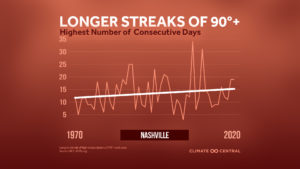
Earth has been pretty hot this summer.
Nashville, too — the city just had its sixth-hottest summer on record.
In June, the average temperature in Nashville was more than three degrees higher than the latest 30-year normal. Tennessee had 60 record daily high temperatures and 85 record daily warm low temperatures, according to the Tennessee Climate Office.
July was the second hottest on record, and an especially brutal heat wave spilled into the month: Nashville had its fifth-longest streak of 90-plus-degree days from mid-June to mid-July. There were several excessive heat warnings in the mix, the highest average overnight temperature recorded for July and only four days that didn’t hit or exceed 90.
Heat streaks have become an important indicator of how people are able to cope with a warming climate, as well as the total number of hot days. Through last Friday, Nashville had 71 days with 90-plus-degree temperatures this year. The climate normal is 49 days per year, and the record is 99 days in 2019, according to the National Weather Service.
Drought gripped much of Middle and West Tennessee during June and through much of July. However, despite intermittent dry conditions exacerbated by heat in a feedback loop, Nashville had it eighth wettest July with about 8 inches, nearly double the normal.
In August, Nashville had pretty average temperatures and precipitation. But the 10 days with rain were also the 10 days with thunder.
These numbers do not tell folks everything about their heat exposure. A new study from scientists at the University of California, Berkley found that the National Weather Service is miscalculating the heat index, sometimes estimating it at 20 degrees below accuracy, during extreme heat. The researchers also suggested that the agency is underestimating how the human body perceives severe hot and humid conditions.
This burden of heat is uneven across Nashville. The city is now in the process of mapping the warmest and coolest parts of town.


